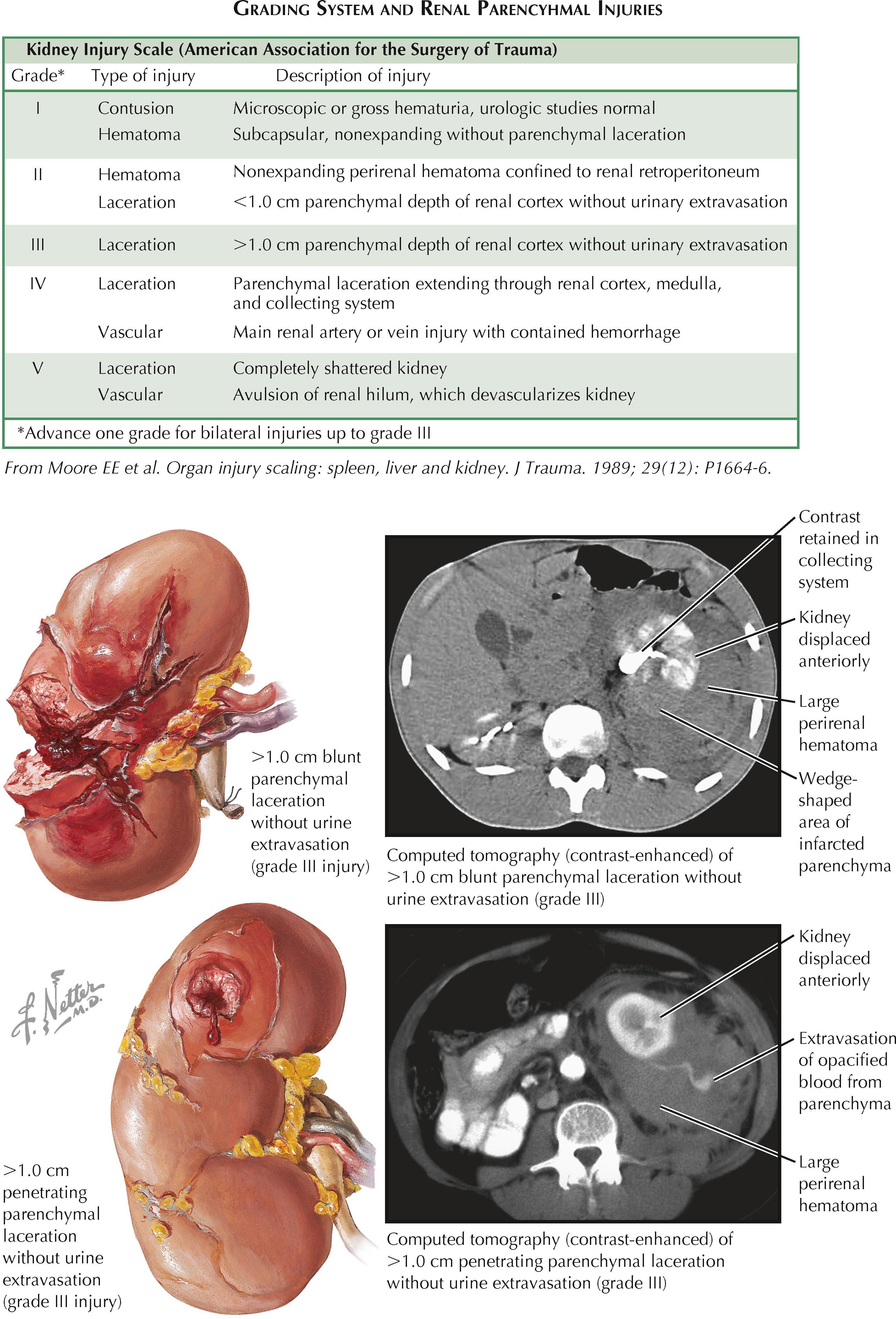Physical Address
304 North Cardinal St.
Dorchester Center, MA 02124
The kidney is injured in up to 5% to 10% of all severe trauma cases. At most urban trauma centers, approximately 80% to 90% of kidney injuries are blunt, while the remainder are penetrating. Children are more likely to sustain blunt renal injuries because of the relative large size of their kidneys, scant perirenal fat, and incomplete rib ossification. Blunt renal injuries are often minor and heal spontaneously, whereas penetrating renal injuries are typically significant and often require intervention.
Patients should be suspected of having renal injury if there is trauma to the flank, abdomen, or lower chest; flank ecchymosis or tenderness; low posterior rib fractures; or lumbar transverse process fractures. Although hematuria is the major symptom and is seen in the vast majority of cases, it may be absent in injuries to the renal pedicle or ureteropelvic junction. In addition, the degree of hematuria often does not correspond to the severity of the renal injury.
A detailed history must be obtained regarding the circumstances of the trauma. Falls or high-speed motor vehicle accidents, for example, may cause deceleration injuries to the renal pedicle. In the setting of gunshot wounds, it is important to determine if the injury is due to a high or low velocity missile because high velocity missiles often cause more extensive kidney injury and delayed necrosis.
The location of any abdominal penetration must also be carefully documented. For example, stab wound entrance sites posterior to the anterior axillary line and below the nipple line are unlikely to have associated intraperitoneal organ injury or to warrant abdominal exploration. The entrance and exit wound sites of a gunshot should be marked with radiopaque markers so that the missile path can be inferred on imaging.
In unstable patients who require immediate abdominal exploration, urologists often advocate for a one-shot intravenous pyelogram. Intravenous contrast is administered at 2 cc/kg of body weight, followed by a single abdominal radiograph 10 minutes later. The primary aim of this study is to determine the function of the contralateral kidney to avoid removing a solitary kidney. In many cases, however, it can produce ambiguous results that are difficult to interpret. Therefore, many trauma surgeons instead simply palpate the contralateral side to assess for the presence of a second kidney. Another option is to infuse intravenous methylene blue and temporarily occlude the ureter ipsilateral to the injured kidney. Blue urine in the Foley bag indicates a functional contralateral kidney.
In stable patients, indications for imaging a suspected kidney injury include:
Blunt trauma and gross hematuria
Blunt trauma, microscopic hematuria (>5 RBC/hpf), and shock
Major acceleration-deceleration injury
Penetrating flank, back, or abdominal trauma associated with gross or microscopic hematuria, or with a missile path that is in line with the kidney
Pediatric trauma with any degree of hematuria
Associated injuries/physical signs suggestive of underlying renal injury

In stable patients, computed tomography (CT) with intravenous contrast is the imaging study of choice for demonstrating renal parenchymal injury, perirenal/retroperitoneal hematomas, urine extravasation, injuries to the renal hilum, and associated intraabdominal organ injuries. It is essential to obtain both an arteriographic phase to assess for major vessel injury and a delayed pyelographic phase to assess for contrast extravasation.
Parenchymal contusions are noted as areas of reduced enhancement, whereas lacerations appear as linear, blood-containing areas that interrupt the parenchyma. Hematomas are visible as hyperattenuating collections that, if large and confined to the subcapsular space, can compress the adjacent renal parenchyma.
Ultrasonography is sometimes used as an initial screen but offers limited value. For example, although ultrasound can demonstrate perirenal fluid collections, it cannot distinguish fresh blood from extravasated urine.
Arteriography and superselective embolization have important roles in the evaluation and treatment of posttraumatic delayed renal bleeding or pseudoaneurysms. In select cases, arteriography and endoluminal stent placement have also been successfully used to manage renal artery intimal tears and thrombosis from blunt trauma.
Based on the findings from imaging studies, injuries can be graded according to criteria set by the American Association for the Surgery of Trauma. The odds of intervention and nephrectomy rise with each increase in grade.
Become a Clinical Tree membership for Full access and enjoy Unlimited articles
If you are a member. Log in here